White-tailed eagle
| White-tailed eagle | |
|---|---|
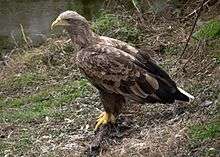 | |
| In captivity | |
| Scientific classification | |
| Kingdom: | Animalia |
| Phylum: | Chordata |
| Class: | Aves |
| Order: | Accipitriformes |
| Family: | Accipitridae |
| Genus: | Haliaeetus |
| Species: | H. albicilla |
| Binomial name | |
| Haliaeetus albicilla (Linnaeus, 1758) | |
| | |
| Range of H. albicilla Nesting range Wintering range Year-round range | |
| Synonyms | |
|
Falco albicilla Linnaeus, 1758 | |
White-tailed eagle (Haliaeetus albicilla) are also known as eagle of the rain, sea grey eagle, erne (sometimes ern, ørn), gray eagle, and white-tailed sea-eagle — is a large bird of prey in the family Accipitridae which includes other raptors such as hawks, kites, and harriers. It is considered a close cousin of the bald eagle and occupies the same ecological niche, but in Eurasia.
Taxonomy
The first formal description of the white-tailed eagle was by the Swedish naturalist Carl Linnaeus in 1758 in the tenth edition of his Systema Naturae under the binomial name Falco albicilla.[2][3] The genus Haliaeetus was introduced in 1809 by the French naturalist Marie Jules César Savigny in the Description de l'Égypte.[4] The name Haliaeetus is New Latin for "sea-eagle", from Ancient Greek hali-, "sea-" and aetos, "eagle". The specific albicilla, "white-tailed", is from New Latin albi-, "white" and cilla, "tail".[5]
Description
The white-tailed eagle is a very large bird. It measures 66–94 cm (26–37 in) in length with a 1.78–2.45 m (5.8–8.0 ft) wingspan. The wingspan, with a midpoint of 2.18 m (7.2 ft), is on average the largest of any eagle.[6][7] The Steller's sea eagle, larger in both weight and total length, is the closest rival for median wingspan amongst living eagles.[6] The bald eagle is roughly the same size as the white-tailed eagle, although has a shorter average wingspan and usually longer total length, due to a longer tail.[6] Females, typically weighing 4–6.9 kg (8.8–15.2 lb), are slightly larger than males, which weigh 3.1–5.4 kg (6.8–11.9 lb).[6] The record weight for the species was 7.5 kg (17 lb) for a specimen from Scotland, while a more recent huge female from Greenland reportedly spanned 2.53 m (8.3 ft) across the wings.[8][9] Among standard measurements, the wing chord is 55.2–71.7 cm (21.7–28.2 in), the tail is 25–33 cm (9.8–13.0 in), the tarsus is 9.2–10.1 cm (3.6–4.0 in) and the exposed culmen is 6–6.5 cm (2.4–2.6 in).[6][10] Size variation is generally a clinal trend: measurements of eagles from Greenland are in general larger than in other populations of the species, while those from the (now discontinuous) population in the Middle East, at the southern extreme of this species distribution, are the smallest in the species.[6][11] The white-tailed eagle is sometimes considered the fourth largest eagle in the world [12] and is on average the fourth heaviest eagle in the world.[6][13]
This species has broad "barn door" wings, a large head and a large thick beak. The adult is mainly grayish-brown except for the slightly paler head and neck, blackish flight feathers, and distinctive white tail. All bare parts are yellow in color, including both the bill and the legs. In juvenile birds, tail and bill are darker, the tail becoming white with a dark terminal band in sub-adults.[14] The combination of mousy-brown coloration, broad, evenly held wings, white tail, strong yellow bill and overall large size render the white-tailed eagle essentially unmistakable in its native range.[6]
Some individuals have been found to live over 25 years,[15] 21 years being the average.[12]
Distribution and systematics
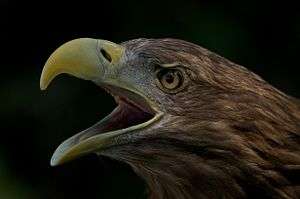
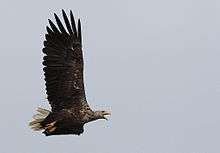
.jpg)
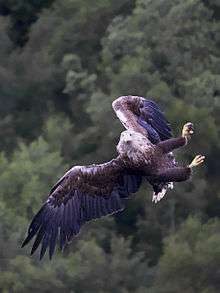
This large eagle breeds in northern Europe and northern Asia. The largest population in Europe is found along the coast of Norway. The population in 2008 stood at 9,000–11,000 pairs.[12] They are mostly resident, only the northernmost birds such as the eastern Scandinavian and Siberian population migrating south in winter. Birds from eastern Russia rarely migrate into Alaska.
Small disjunct resident populations occur in southwesternmost Greenland and western Iceland. The former has been proposed as a distinct subspecies, groenlandicus, based on their very large size and body proportions. However, the species is now considered monotypic and the size variation is clinal according to Bergmann's rule.[16] A recent genetic study of mitochondrial DNA[17] is consistent with this idea. Greenlandic white-tailed eagles form, on evolutionary time scales, a relatively recently founded population that has not yet accumulated many unique genetic characteristics. However, the population appears to be demographically isolated and deserves special protection.
The white-tailed eagle forms a species pair with the bald eagle. These diverged from other sea eagles at the beginning of the early Miocene (c. 10 mya) at the latest, possibly (if the most ancient fossil record is correctly assigned to this genus) as early as the early or middle Oligocene, about 28 mya.[18]
As in other sea-eagle species pairs, this one consists of a white-headed (the bald eagle) and a tan-headed species. They probably diverged in the North Pacific, spreading westwards into Eurasia and eastwards into North America. Like the third large northern species, Steller's sea eagle, adults have yellow feet, beaks and eyes.
Currently, eagles only occur in the Hawaiian Islands as vagrants, but Quaternary bones of Haliaeetus have been found on three of the major islands. An ancient DNA study published in 2015 characterized the rapidly evolving mitochondrial control region of one of these specimens.[19] DNA from a ∼3500-year-old sea eagle skeleton found in a lava cave on Maui was sequenced. Phylogenetic analyses suggested that the Hawaiian eagle represents a distinct (>3% divergent) mtDNA lineage that is most closely related to extant white-tailed eagles. Based on fossil calibration, the Hawaiian mtDNA lineage probably diverged around the Middle Pleistocene. Thus, although not clearly differentiated in morphology from its relatives, the Hawaiian eagle likely represented an isolated, resident population in the Hawaiian archipelago for more than 100,000 years, where it was the largest terrestrial predator. The reasons for its extinction are unknown.
Diet
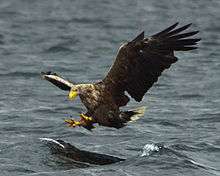
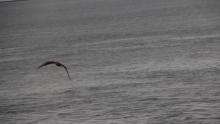
The white-tailed eagle's diet is varied, opportunistic and seasonal. Prey specimens can often include fish, birds and mammals. Many birds live largely as scavengers, regularly pirating food from otters and other birds including cormorants, gulls, ospreys and various other raptors.[6] Carrion is often the primary food source during lean winter months, with fish and ungulates preferred but everything from cetaceans to livestock to even humans being eaten after death.[6][20] Among the scavengers in their range, eagles are often dominant over all but perhaps the largest carnivorous mammals (i.e. gray wolves, etc.)[6] However, this eagle can be a powerful hunter as well. In Scotland, the diet of this species differs significantly from that of sympatric golden eagles, as is also the case in Norway.[6] The daily food requirement for a white-tailed eagle is in range of 500–600 g (1.1–1.3 lb).[21] Although generally a less active hunter than the golden eagle, competition over food can go either way depending on the individual eagle. They can exist at higher population densities and typically outnumber golden eagles because of their longer gut and more efficient digestive system, being able to live better with less food.[22]
Virtually any fish found near the surface is potential prey for the white-tailed eagle.[6] Commercial fisheries and carp ponds are readily exploited by the eagles when available.[6] Although, given the opportunity, they occasionally kill and harass some land birds, white-tailed eagles usually target water-based birds as prey.[6] In the Baltic, the diet of this species consists mainly of sea birds (from the little tern to the great skua) and pike. Recently they are reported to have attacked and eaten great cormorants and in some cases destroyed whole colonies.[23] In the Estonian island of Hiiumaa, home to at least 25 pairs of sea eagles, as many as 26 individuals have been observed simultaneously culling a single cormorant colony.[24] In the UK, fulmar are noted as a common prey species and as such may contribute to locally high levels of DDT and PCB chemicals in nesting eagles.[20] Additionally, loons, grebes, ducks, coots, auks, gulls, geese and even swans have been preyed upon.[6] Adults, nestlings and eggs of other birds are all regularly consumed. When preying upon non-nesting birds, white-tailed eagles often fly towards a waterbird repeatedly, forcing it to dive again and again until the bird is exhausted and more easily caught.[6] Very large prey such as swans may be dragged along the surface of the water to the shore to be consumed.[6] Live mammals consumed have ranged in size from voles to lambs and deer calves, the latter likely around the same size as the record-sized deer carried by bald eagles in North America.[6]
Breeding
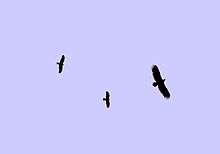
White-tailed eagles are sexually mature at four to five years of age. They pair for life, though if one dies replacement can occur quickly. A bond is formed when a permanent home range is chosen. They have a characteristic aerial courtship display which culminates in the pair locking talons mid-air and whirling earthwards in series of spectacular cartwheels. White-tailed eagles are much more vocal than golden eagles, particularly during the breeding season and especially the male when near the eyrie. Calls can sometimes take the form of a duet between the pair.
The nest is a huge edifice of sticks in a tree or on a coastal cliff. Being faithful to their territories, once they breed, nests are often reused, sometimes for decades by successive generations of birds; one nest in Iceland has been in use for over 150 years.[14] In Scandinavia, trees have been known to collapse under the weight of enormous, long-established nests.
The territory of the white-tailed eagle ranges between 30 and 70 km2 (12 and 27 sq mi), normally in sheltered coastal locations. Sometimes they are found inland by lakes and along rivers. Territory of white-tailed eagles can overlap with those of the golden eagle but competition between the two species is limited. Golden eagles prefer mountains and moorland, while the white-tailed eagle prefers the coast and the sea. In adulthood, the white-tailed eagle has no natural predators and is thus considered an apex predator.
Mated pairs produce one to three eggs per year, laid two to five days apart in March or April and incubated for 38 days by both parents. Once hatched, chicks are quite tolerant of one another, although the first hatched is often larger and dominates at feeding times. The female does most of the brooding and direct feeding, with the male taking over now and then. Young are able to feed themselves from five to six weeks and they fledge at eleven to twelve weeks, remaining in the vicinity of the nest, dependent on their parents for a further six to ten weeks. The sex of nestlings can be identified using field methods, or using DNA.[25]
Surplus chicks are sometimes removed from nests to use in reintroduction programs in areas where the species has died out. If left in the nest, they often die sooner or later, as with most large eagles. In such programs the birds are raised in boxes on platforms in the tree canopy and fed in such a way that they cannot see the human supplying their food, until they are old enough to fly and thus find their own food.
Near-extinction and recovery in Europe
White-tailed eagles, being apex predators, tend to experience bioaccumulation from environmental pollutants present in their prey; they also suffer intensive persecution by shepherds and gamekeepers who consider them (usually wrongly[22]) a threat to their livestock and gamebirds. During the period 1800-1970, white-tailed eagles in most of Europe underwent dramatic declines and became extinct in many regions of western, central and southern Europe.
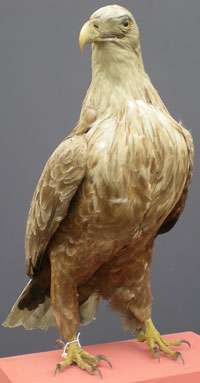
A white tailed eagle was shot in the winter of 1857 at Stolford in Bridgwater Bay and subsequently preserved for display. It may be seen at the Somerset Heritage Centre (TA2 6SF). It was presented to the county museum by Miss Bailey, the executrix of the owner's will, in 1881.[26]
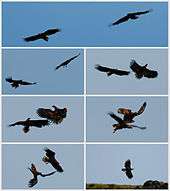
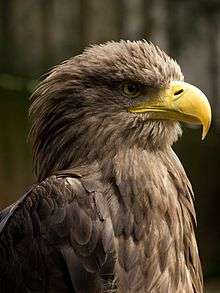
While Norway, Germany, Poland and Iceland harboured the largest surviving populations, pockets of reproducing pairs remained in several other countries.[27] Intense conservation actions throughout much of the remaining European distribution range (legal protection to decrease hunting, protection of breeding sites, and winter feeding) led to recovery of many local populations. Since the 1980s, the European white-tailed eagle population has recovered steadily and is spreading back westward. It has today recolonised several traditional breeding areas in Europe. This ongoing recovery is assisted in Scotland and Ireland by reintroduction schemes.[14][21]
Some threats still remain, notably illegal persecution by gamebird shooting and egg thieves in Scotland.[28] A new threat from wind turbines is emerging with significant mortality (considerably in excess of the area's population productivity) occurring at the Smøla Windfarm in Norway.[29][30]
White-tailed eagles were successfully reintroduced to the Isle of Rum, in the Small Isles archipelago in Scotland, in 1975 and now breeds throughout the Western Isles and the mainland coast of Wester Ross. It has many Gaelic names, including iolar sùil na grèine or 'eagle of the sun's eye.'[12] In August 2008, fifteen chicks raised in Norway were released at a secret location in Fife, in expectation of reintroducing the species to the east coast of Scotland as well.[31] The white-tailed eagle is still a rare breeder in Britain following its extinction and reintroduction, with 36 pairs in 2006 and 40 in 2008.[12][14][28]
On 22 May 2006, it was announced that a pair of white-tailed eagles breeding in the Oostvaardersplassen nature reserve in the Netherlands had arrived on their own, not as a reintroduction. This was the first time the bird has bred in the Netherlands in living memory. In 2007, 2008 and 2009 the eagles returned to their nest.[32] In 2010, it turned out that the white-tailed eagle was also breeding in the Zwarte Meer nature district and in the Lauwersmeer area.[33] There is also a confirmed case of breeding white-tailed eagles in the Biesbosch.
The white-tailed eagle is being reintroduced to Ireland, where its Irish name of Iolar Mara (sea eagle) reflects its historic association with the island's long coast. The program was begun in the summer of 2007. Fifteen to twenty young eagles from Norway are being released each spring into the Killarney National Park in the south-west of Ireland. This comprehensive project will last a number of years, with many more eagles being released. The species has a rich history on the island but became extinct in Ireland in the 1900s due to persecution from landowners.[34] The last pair bred on the coast of Mayo in 1912.[35]
In 2007, a hundred local sheep farmers gathered at Kerry airport to protest the eagles' arrival. Irish Farming Association Hill Committee chairman Mr O'Leary said he had no doubt the eagles would take lambs.[36] Since their reintroduction seven eagles have been confirmed poisoned in County Kerry, two suspected of having been poisoned, and one shot. A 13th eagle released in Kerry was shot in Northern Ireland. Twenty more eagles were due for release in 2010. However, Dr Allan Mee, in charge of the sea eagle project, stated "the continuing loss of eagles to poisoning had cast a shadow over the future of the ambitious programme."[37] The first white-tailed eagle breeding pair since 1912 nested 100 years later on Lough Derg (Loch Deirgeirt), marking a great success for the Irish reintroduction programme.[38] In early May 2013, the first eaglets were born in Ireland since the re-introduction programme began; one in the Killarney National Park and two in County Clare.[39] In Spring 2015, five nests hatched chicks in 4 counties in Ireland - Clare, Cork, Galway and Kerry.[40]
Studies of microsatellite and mitochondrial DNA in white-tailed eagles from north-central Europe have shown that the recovering European population has retained appreciable amounts of genetic diversity, implying low risk of inbreeding depression (a serious concern in species with low population density). Therefore, recovery of this formerly endangered species is a true success story for nature conservation. The story also shows how local protection of a species can be successful and important for preserving the species' evolutionary potential.[27][41][42]
Heraldry
It is believed to be the White eagle shown in the Polish coat of arms and in the Serbian coat of arms.[43] The sea eagle is often blazoned grasping a fish (usually a pike) in its talons, distinguishing it from an ordinary eagle.
Prehistory
On Orkney, (Scotland), sea eagle bones have been found in 6000-year-old burial mounds, suggesting that the birds were revered by the prehistoric people there, a belief strengthened by the Pictish stone carvings of sea eagles from Orkney.[12]
Cut marks have been found in white-tailed eagle talons in Krapina, suggesting Neanderthals' use of jewelry.[44]
Folklore
In the Shetland Isles (Scotland), fishermen believed that as soon as a sea eagle appeared fish would rise to the surface, belly up; this led to some fishermen using eagle fat, smeared on their bait, to increase their catch.[12]
Footnotes
- ↑ IUCN Red List 2013.
- ↑ Linnaeus, C. (1758). Systema Naturæ per regna tria naturae, secundum classes, ordines, genera, species, cum characteribus, differentiis, synonymis, locis, Volume 1 (in Latin) (10th ed.). Holmiae:Laurentii Salvii. p. 89.
- ↑ Mayr, Ernst; Cottrell, G. William, eds. (1979). Check-list of Birds of the World. Volume 1 (2nd ed.). Cambridge, Massachusetts: Museum of Comparative Zoology. p. 301.
- ↑ Savigny, Marie Jules César (1809). Description de l'Égypte: Histoire naturelle Volume 1 (in French). Paris: Imprimerie impériale. pp. 68, 85.
- ↑ Jobling, James A. (2010). The Helm Dictionary of Scientific Bird Names. London: Christopher Helm. pp. 38, 185. ISBN 978-1-4081-2501-4.
- 1 2 3 4 5 6 7 8 9 10 11 12 13 14 15 16 17 18 19 Ferguson-Lees, J.; Christie, D. (2001). Raptors of the World. London: Christopher Helm. ISBN 0-7136-8026-1.
- ↑ National Geographic Field Guide to the Birds of North America (4th ed.). Washington, D.C.: National Geographic. 2002. ISBN 978-0792268772.
- ↑ Wood, Gerald (1983). The Guinness Book of Animal Facts and Feats. ISBN 978-0-85112-235-9.
- ↑ Smárason, Hjörtur (29 March 2011). "World's Largest White-tailed Eagle".
- ↑ "Haliaeetus albicilla". AVIS-IBIS: Birds of Indian Subcontinent. External link in
|website=(help) - ↑ Brown, L.H.; Amadon, D. (1968). Eagles, hawks and falcons of the world. Vol. 1. Hamlyn Publishing Group.
- 1 2 3 4 5 6 7 The Nature of Scotland, p. 49.
- ↑ Handbook of the Birds of the World. Barcelona: Lynx Edicions.
- 1 2 3 4 Snow & Perrins 1998.
- ↑ "Merikotkien määrä lisääntyy" [Eagles are increasing] (in Finnish). MTV3.fi. 10 July 2008. Retrieved 30 May 2011.
- ↑ del Hoyo, Elliott & Sargatal 1994.
- ↑ Hailer et al. 2007.
- ↑ Wink, Heidrich & Fentzloff 1996.
- ↑ Hailer, Frank; James, Helen F.; Olson, Storrs L.; Fleischer, Robert C. (2015). "Distinct and Extinct: Genetic Differentiation of the Hawaiian Eagle". Molecular Phylogenetics and Evolution. 83: 40–43. doi:10.1016/j.ympev.2014.11.005.
- 1 2 "White-tailed eagle: Feeding". RSPB. Retrieved 3 February 2012.
- 1 2 Cramp 1980.
- 1 2 Halley 1998.
- ↑ "Turun Sanomat: Merikotkat oppineet syömään aikuisiakin merimetsoja" (in Finnish). Retrieved 3 February 2012.
- ↑ "Kormoraniküttidel läheb hästi" [Cormorant Hunters are doing well]. Hiumaa Life (in Estonian). 13 April 2012. External link in
|website=(help) - ↑ Helander, Hailer & Vilà 2007.
- ↑ "The Somerset Natural History and Archaeological Society". The Proceedings. XXV1: Page 86. 1881.
- 1 2 Hailer et al. 2006.
- 1 2 "Birds of prey: Which birds are threatened?". RSPB. 23 January 2008.
- ↑ "Wind farm causes eagle deaths". BirdLife International. 3 February 2006. Archived from the original on 22 September 2013.
- ↑ Unwin, Brian (4 July 2014). "Arrivals & Alarms: White-tailed Eagle Imports Endangered by Windfarms". fatbirder.com. External link in
|website=(help) - ↑ "Birds released in secret location". BBC News. 13 August 2008. Retrieved 13 August 2008.
- ↑ The Dutch national forestry, which owns the reserve, has put up a webcam trained on the nesting eagles Archived March 10, 2007, at the Wayback Machine.
- ↑ Janssen, Caspar (24 March 2010). "Zeearend nestelt zich in Nederland" [White-tailed eagle nests in the Netherlands] (in Dutch). Volkskrant.nl. Retrieved 30 May 2011. External link in
|publisher=(help) - ↑ "Rare eagle reintroduced to Ireland". RTÉ News. RTÉ. 16 August 2007. External link in
|website=(help) - ↑ "White-tailed Eagle". BirdWatch Ireland. External link in
|website=(help) - ↑ "Farmers protest at the arrival of the Eagles in 2007". Drimnagh Birdwatch. 4 March 2010. Archived from the original on 14 November 2012. Retrieved 30 May 2011.
- ↑ Lucey, Anne (4 May 2010). "Sea eagle death in Kerry park brings total to 13". The Irish Times. Retrieved 30 May 2011. External link in
|newspaper=(help) - ↑ Siggins, Lorna (30 April 2012). "Sea eagles return to Irish nest". The Irish Times. Retrieved 30 April 2012. External link in
|newspaper=(help) - ↑ "First white-tailed eagles born in Ireland in over 100 years". Raidió Teilifís Éireann. 9 May 2013. Retrieved 20 May 2013.
- ↑ "White-tailed eagle chicks hatch in five nests". The Irish Times. 2 Jun 2015.
- ↑ Hailer 2006.
- ↑ Hailer, Gautschi & Helander 2005.
- ↑ "Polish Birds Directory". birds.poland.pl. Archived from the original on 19 October 2011. Retrieved 30 May 2011. External link in
|website=(help) - ↑ Radovčić, D.; Sršen, A.O.; Radovčić, J.; Frayer, D.W. (2015). "Evidence for Neandertal Jewelry: Modified White-Tailed Eagle Claws at Krapina". PLoS ONE. 10 (3 e0119802): e0119802. doi:10.1371/journal.pone.0119802.
- References
- BirdLife International (2013). "Haliaeetus albicilla". IUCN Red List of Threatened Species. Version 2013.2. International Union for Conservation of Nature. Retrieved 26 November 2013.
- Cited works
- Cramp, Stanley, ed. (1980). The Birds of the Western Palearctic. 2. Oxford University Press. ISBN 0-19-857505-X.
- del Hoyo, J.; Elliott, A.; Sargatal, J., eds. (1994). Handbook of the Birds of the World. 2. Barcelona: Lynx Edicions. ISBN 84-87334-15-6.
- Ferguson-Lees, James; Christie, David A. (2001). Raptors of the World. Illustrated by Kim Franklin, David Mead, and Philip Burton. Houghton Mifflin. ISBN 978-0-618-12762-7. Retrieved 2011-05-29.
- Hailer, Frank (2006). Conservation genetics of the white-tailed eagle (Haliaeetus albicilla). PhD thesis. Sweden: Uppsala University. ISBN 978-91-554-6581-0. OCLC 185328184. Retrieved 2011-05-30.
- Hailer, Frank; Gautschi, Barbara; Helander, Björn (2005). "Development and multiplex PCR amplification of novel microsatellite markers in the White-tailed Sea Eagle, Haliaeetus albicilla (Aves: Falconiformes, Accipitridae)". Molecular Ecology Notes. 5 (4): 938–940. doi:10.1111/j.1471-8286.2005.01122.x.
- Hailer, F.; Helander, B.; Folkestad, A. O.; Ganusevich, S. A.; Garstad, S.; Hauff, P.; Koren, C.; Nygard, T.; Volke, V.; Vilà, C.; Ellegren, H. (2006). "Bottlenecked but long-lived: High genetic diversity retained in white-tailed eagles upon recovery from population decline". Biology Letters. 2 (2): 316–319. doi:10.1098/rsbl.2006.0453. PMC 1618921
 . PMID 17148392. Electronic appendix
. PMID 17148392. Electronic appendix - Hailer, F.; Helander, B.; Folkestad, A. O.; Ganusevich, S. A.; Garstad, S.; Hauff, P.; Koren, C.; Masterov, V. B.; Nygård, T.; Rudnick, J. A.; Saiko, S.; Skarphedinsson, K.; Volke, V.; Wille, F.; Vilà, C. (2007). "Phylogeography of the white-tailed eagle, a generalist with large dispersal capacity". Journal of Biogeography. 34 (7): 1193–1206. doi:10.1111/j.1365-2699.2007.01697.x.
- Halley, D.J. (1998). "Golden and white-tailed eagles in Scotland and Norway. Coexistence, competition and environmental degradation". British Birds. 91 (5): 171–179. ISSN 0007-0335.
- Helander, Björn; Hailer, Frank; Vilà, Carles (2007). "Morphological and genetic sex identification of white-tailed eagle Haliaeetus albicilla nestlings". Journal of Ornithology. 148 (4): 435–442. doi:10.1007/s10336-007-0156-y.
- Scottish Natural Heritage (Spring 2009). "The Nature of Scotland". OCLC 310094759.
- Snow, David W.; Perrins, Christopher M. (1998). The Birds of the Western Palearctic (Concise ed.). Oxford University Press. ISBN 0-19-854099-X.
- Wink, M.; Heidrich, P.; Fentzloff, C. (1996). "A mtDNA phylogeny of sea eagles (genus Haliaeetus) based on nucleotide sequences of the cytochrome b gene" (PDF). Biochemical Systematics and Ecology. 24 (7–8): 783–791. doi:10.1016/S0305-1978(96)00049-X.. The authors' reservations about using the generalised "2%" rate of molecular evolution have since proven to be well founded.
Further reading
- Identification
- Grant, Peter J. (1988). "The Co. Kerry Bald Eagle". Twitching. 1 (12): 379–380.
describes plumage differences between Bald Eagle and White-tailed Eagle in juvenile plumage
- Extinction in Scotland
- Harvie-Brown, J.A.; Buckley, T.E. (1892). A Vertebrate Fauna of Argyll and the Inner Hebrides. Edinburgh: David Douglas. pp. 104–107.
- Harvie-Brown, J.A.; Buckley, T.E. (1888). A Vertebrate Fauna of the Outer Hebrides. Edinburgh: David Douglas. pp. 84–87.
External links
| Wikimedia Commons has media related to Haliaeetus albicilla. |
| Wikispecies has information related to: Haliaeetus albicilla |
- White-tailed Eagle Webcam - Smøla, Norway
- White-tailed Eagle at RSPB: Birds by Name
- Live webcam nest White-tailed Eagle, Oostvaardersplassen, Netherlands.
- Fieldguide page on Flickr
- White-tailed Eagles in Scotland. BBC website.
- BirdLife species factsheet for Haliaeetus albicilla
- "Haliaeetus albicilla". Avibase.

- "White-tailed Sea-eagle media". Internet Bird Collection.
- White-tailed eagle photo gallery at VIREO (Drexel University)
- Audio recordings of White-tailed eagle on Xeno-canto.

.jpg)
